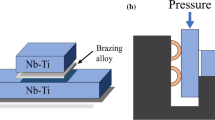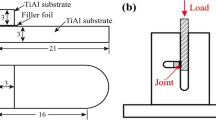Abstract
Ti–6Al–4V (TC4) and Ti–6.5Al–3.5Mo–1.5Zr–0.3Si (TC11) joints were achieved via Ti–37.5Zr–15Ni–10Cu (wt%) filler metal when the brazing temperature was in the range from 950 °C (below β-transus) to 1040 °C (above β-transus) for 10–60 min. The role of brazing parameters in the microstructure evolution as well as mechanical properties of both base alloys and brazed joints was studied. The research analysis suggested that the typical interfacial microstructure was divided into five characteristic zones including reaction phases of α-Ti, β-Ti and (Ti, Zr)2CuNi. With the holding time prolonged, the sectionalized structure transformed into lamellar Widmanstätten structure in the brazing seam at the temperature of 950 °C, and the optimized shear strength reached 616 MPa at 950 °C for 60 min. Nevertheless, when increasing the brazing temperature to 1000 °C, the joint shear strength tended to be stable as the holding time exceeded 20 min due to the elemental homogenization, and the shear strength reached 627 MPa for the holding time of 20 min. Tensile test results showed that the mechanical properties of both TC4 and TC11 alloys were dramatically degraded at the heat treatment temperature of 1000 °C owning to the drastic grain coarsening and phase transition. Additionally, the plastic strain of TC4/TC11 joint brazed at 1000 °C for 20 min was 1.66%, while that of joint brazed at 950 °C for 60 min reached 2.01%. The variation in mechanical properties of base alloys as well as brazed joints under different thermal conditions revealed that the optimized temperature for brazing of titanium alloys was lower than β-transus with a long time.
















Similar content being viewed by others
References
Zhao P, Fu L, Chen H. Low cycle fatigue properties of linear friction welded joint of TC11 and TC17 titanium alloys. J Alloy Compd. 2016;675:248–56. https://doi.org/10.1016/j.jallcom.2016.03.113.
Yadroitsev I, Krakhmalev P, Yadroitsava I. Selective laser melting of Ti6Al4V alloy for biomedical applications: temperature monitoring and microstructural evolution. J Alloy Compd. 2014;583:404–9. https://doi.org/10.1016/j.jallcom.2013.08.183.
Song HW, Zhang SH, Cheng M. Dynamic globularization kinetics during hot working of a two phase titanium alloy with a colony alpha microstructure. J Alloy Compd. 2009;480(2):922–7. https://doi.org/10.1016/j.jallcom.2009.02.059.
Wang T, Yu B, Han K, Peng F, Jiang S, Zhao H, et al. Effect of heat input on microstructure and mechanical properties of Ti/Cu66V34/Cu joints by electron beam welding. J Manuf Process. 2019;45:147–53. https://doi.org/10.1016/j.jmapro.2019.07.005.
Hao X, Dong H, Li S, et al. Lap joining of TC4 titanium alloy to 304 stainless steel with fillet weld by GTAW using copper-based filler wire. J Mater Process Technol. 2018;257:88–100. https://doi.org/10.1016/j.jmatprotec.2018.02.020.
Song X, Ben B, Hu S, Feng J, Tang D. Vacuum brazing high Nb-containing TiAl alloy to Ti60 alloy using Ti-28Ni eutectic brazing alloy. J Alloy Compd. 2017;692:485–91. https://doi.org/10.1016/j.jallcom.2016.09.074.
Wang XR, Yang YQ, Luo X, Zhang W, Zhao GM, Huang B. An investigation of Ti–43Al–9V/Ti–6Al–4V interface by diffusion bonding. Intermetallics. 2013;36:127–32. https://doi.org/10.1016/j.intermet.2012.12.018.
Chan HY, Liaw DW, Shiue RK. The microstructural observation of brazing Ti–6Al–4V and TZM using the BAg-8 braze alloy. Int J Refract Metal Hard Mater. 2004;22(1):27–33. https://doi.org/10.1016/j.ijrmhm.2003.11.002.
Chen X, Yan J, Gao F, Wei J, Xu Z, Fan G. Interaction behaviors at the interface between liquid Al–Si and solid Ti–6Al–4V in ultrasonic-assisted brazing in air. Ultrason Sonochem. 2013;20(1):144–54. https://doi.org/10.1016/j.ultsonch.2012.06.011.
Yang TY, Shiue RK, Wu SK. Infrared brazing of Ti50Ni50 shape memory alloy using pure Cu and Ti–5Cu–15Ni foils. Intermetallics. 2004;12(12):1285–92. https://doi.org/10.1016/j.intermet.2004.03.020.
Chang CT, Du YC, Shiue RK, Chang CS. Infrared brazing of high-strength titanium alloys by Ti–15Cu–15Ni and Ti–15Cu–25Ni filler foils. Mater Sci Eng A. 2006;420(1):155–64. https://doi.org/10.1016/j.msea.2006.01.046.
Pang S, Sun L, Xiong H, Chen C, Liu Y, Li H, et al. A multicomponent TiZr-based amorphous brazing filler metal for high-strength joining of titanium alloy. Scripta Mater. 2016;117:55–9. https://doi.org/10.1016/j.scriptamat.2016.02.006.
Ganjeh E, Sarkhosh H, Bajgholi ME, Khorsand H, Ghaffari M. Increasing Ti–6Al–4V brazed joint strength equal to the base metal by Ti and Zr amorphous filler alloys. Mater Charact. 2012;71:31–40. https://doi.org/10.1016/j.matchar.2012.05.016.
Ganjeh E, Sarkhosh H. Microstructural, mechanical and fractographical study of titanium-CP and Ti–6Al–4V similar brazing with Ti-based filler. Mater Sci Eng A. 2013;559:119–29. https://doi.org/10.1016/j.msea.2012.08.043.
Chang CT, Wu ZY, Shiue RK, Chang CS. Infrared brazing Ti–6Al–4V and SP-700 alloys using the Ti–20Zr–20Cu–20Ni braze alloy. Mater Lett. 2007;61(3):842–5. https://doi.org/10.1016/j.matlet.2006.05.077.
Shapiro A, Rabinkin A. State of the art of titanium-based brazing filler metals. Weld J. 2003;82(10):36–433.
Zhang H, Li J, Ma P, Xiong J, Zhang F. Study on microstructure and impact toughness of TC4 titanium alloy diffusion bonding joint. Vacuum. 2018;152:272–7. https://doi.org/10.1016/j.vacuum.2018.03.019.
Gu Y, Zeng F, Qi Y, Xia C, Xiong X. Tensile creep behavior of heat-treated TC11 titanium alloy at 450–550 °C. Mater Sci Eng A. 2013;575:74–85. https://doi.org/10.1016/j.msea.2013.03.038.
Lee MK, Lee JG. Mechanical and corrosion properties of Ti–6Al–4V alloy joints brazed with a low-melting-point 62.7Zr–11.0Ti–13.2Cu–9.8Ni–3.3Be amorphous filler metal. Mater Charact. 2013;81:19–27. https://doi.org/10.1016/j.matchar.2013.04.002.
Yuan L, Xiong JT, Du YJ, et al. Effects of pure Ti or Zr powder on microstructure and mechanical properties of Ti6Al4V and Ti2AlNb joints brazed with TiZrCuNi. Mater Sci Eng A. 2020. https://doi.org/10.1016/j.msea.2020.139602.
Lee MK, Kim KH, Lee JG, Rhee CK. Growth of isothermally-solidified titanium joints using a multi-component Zr–Ti–Cu–Ni–Be amorphous alloy as a brazing filler. Mater Charact. 2013;80:98–104. https://doi.org/10.1016/j.matchar.2013.03.015.
Wang Y, Jiao M, Yang Z, Wang D, Liu Y. Vacuum brazing of Ti2AlNb and TC4 alloys using Ti–Zr–Cu–Ni and Ti–Zr–Cu–Ni + mo filler metals: microstructural evolution and mechanical properties. Arch Civil Mech Eng. 2018;18(2):546–56. https://doi.org/10.1016/j.acme.2017.10.006.
Appolaire B, Héricher L, Aeby-Gautier E. Modelling of phase transformation kinetics in Ti alloys—isothermal treatments. Acta Mater. 2005;53(10):3001–11. https://doi.org/10.1016/j.actamat.2005.03.014.
Sun Z, Guo S, Yang H. Nucleation and growth mechanism of α-lamellae of Ti alloy TA15 cooling from an α+β phase field. Acta Mater. 2013;61(6):2057–64. https://doi.org/10.1016/j.actamat.2012.12.025.
Acknowledgements
The authors gratefully acknowledge the financial support from Science and Technology Program of Tianjin (Grant no.18ZXCLGX00060) and National Natural Science Foundation of China (Grant no.51875400).
Author information
Authors and Affiliations
Corresponding authors
Ethics declarations
Conflict of interest
The authors declare that they have no known competing financial interests or personal relationships that could have appeared to influence the work reported in this paper.
Ethical statement
The article was conducted according to ethical standards.
Rights and permissions
About this article
Cite this article
Yang, Z., Chen, Y., Niu, S. et al. Phase transition, microstructural evolution and mechanical properties of Ti–6Al–4V and Ti–6.5Al–3.5Mo–1.5Zr–0.3Si joints brazed with Ti–Zr–Ni–Cu filler metal. Archiv.Civ.Mech.Eng 20, 88 (2020). https://doi.org/10.1007/s43452-020-00093-3
Received:
Revised:
Accepted:
Published:
DOI: https://doi.org/10.1007/s43452-020-00093-3




